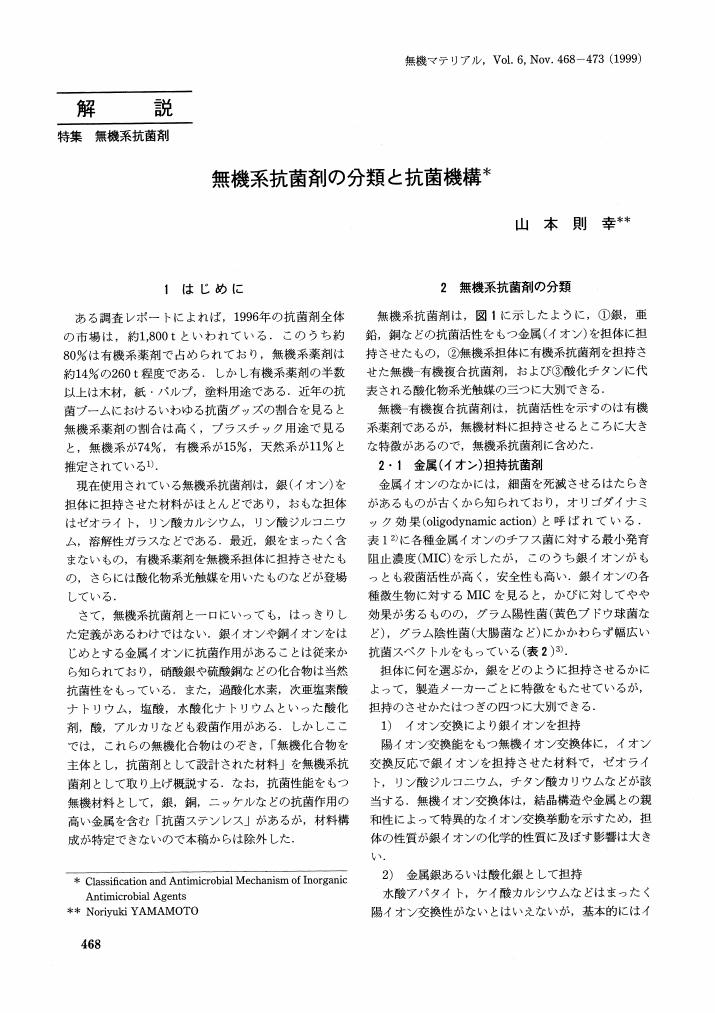10 0 0 0 OA 酸化チタンの光触媒反応を利用した抗菌作用
6 0 0 0 OA カルシウム, マグネシウムの生体中での挙動
5 0 0 0 OA 熱力学的に見た製鉄の歴史
4 0 0 0 OA 銀系ゼオライト抗菌剤
3 0 0 0 OA 無機系抗菌剤の分類と抗菌機構
1 0 0 0 OA 無機系殺菌・不活化材料の研究動向
1 0 0 0 OA 結晶の形態および凝集状態の制御 液相から生成する場合
- 著者
- 久保田 徳昭
- 出版者
- 無機マテリアル学会
- 雑誌
- 無機マテリアル (ISSN:2185436X)
- 巻号頁・発行日
- vol.2, no.258, pp.320-328, 1995-09-01 (Released:2011-03-07)
- 参考文献数
- 24
1 0 0 0 OA 重油燃焼灰のバナジウム回収
- 著者
- 三浦 啓一 望月 大祐 仙波 裕隆 丸田 俊久 橋本 和明 戸田 善朝
- 出版者
- 無機マテリアル学会
- 雑誌
- 無機マテリアル (ISSN:2185436X)
- 巻号頁・発行日
- vol.6, no.280, pp.213-219, 1999-05-01 (Released:2011-03-07)
- 参考文献数
- 9
The fundamental experiment for the purpose of recovery of vanadium from oil burning ash, which was the valuable resources in Japan, was carried out. The following summarized the results.Sulfuric acid was superior to aqueous ammonia as extraction media in the process of leaching vanadium ion from oil burning ash.Precipitation ratio of vanadium compounds at room temperature was low. For example, the yield of vanadium compounds for 259200 s was no more than 60%. On the contrary, the precipitation rate increased at the higher reaction temperature and the yield reached up to approximately 100% at 80°C.Initial concentration of vanadium ion was the important factor besides pH and reaction temperature. The higher initial concentration of vanadium ion enlarged the appropriate pH range for the precipitation. In the case of 16000 ppm of the initial concentration, the pH range was 2.0 to 2.8. It was wider than that of 4000 ppm or 8000 ppm.The above results suggested that the higher initial concentration of vanadium ion, proper pH and higher reaction temperature were necessary to recover vanadium from oil burning ash efficiently.
1 0 0 0 OA セラミックス成形の技術
- 著者
- 植松 敬三
- 出版者
- 無機マテリアル学会
- 雑誌
- 無機マテリアル (ISSN:2185436X)
- 巻号頁・発行日
- vol.3, no.263, pp.332-339, 1996-07-01 (Released:2011-03-07)
- 参考文献数
- 12
1 0 0 0 OA 銀添加セラミックスの抗菌作用機構
- 著者
- 今井 茂雄 久野 裕明 山田 剛 前田 拓也 高麗 寛紀
- 出版者
- 無機マテリアル学会
- 雑誌
- 無機マテリアル (ISSN:2185436X)
- 巻号頁・発行日
- vol.6, no.283, pp.451-456, 1999-11-01 (Released:2011-03-07)
- 参考文献数
- 14
The silver-doped ceramics is the whitewares coated with low-temperature lime zinc glaze containing silver, and has bactericidal activity. In this study, the mechanism of the bactericidal action of the silver-doped ceramics against bacteria, mainly Escherichia coli K12 W3110, was investigated. The silver-doped ceramics had high bactericidal activity when it was irradiated by visible light. Since the eluted silver ions from the surface of ceramics were not detected by ICP measurement and the supernatant had no bactericidal activity, it was proved that the eluted silver ions do not contribute to the bactericidal action of the ceramics. The bactericidal activity was extremely inhibited in the presence of radical scavengers such as L-cysteine, L-alanine or I-. After the silver-doped ceramics was removed from the cell suspension irradiated for 60 min, the bactericidal activity was still maintained, and was inhibited by L-cysteine. The silver-doped ceramics also had bactericidal activity against Bacillus subtilis ATCC6633.These results suggest that the bactericidal action of silver-doped ceramics is caused by the hydroxyl radical which is generated on the surface of the ceramics by light irradiation and is converted to a living radical in bacterial cells.
1 0 0 0 OA 無機系抗菌剤の開発の現状と将来
- 著者
- 高麗 寛紀
- 出版者
- 無機マテリアル学会
- 雑誌
- 無機マテリアル (ISSN:2185436X)
- 巻号頁・発行日
- vol.6, no.283, pp.428-436, 1999-11-01 (Released:2011-03-07)
- 参考文献数
- 14








